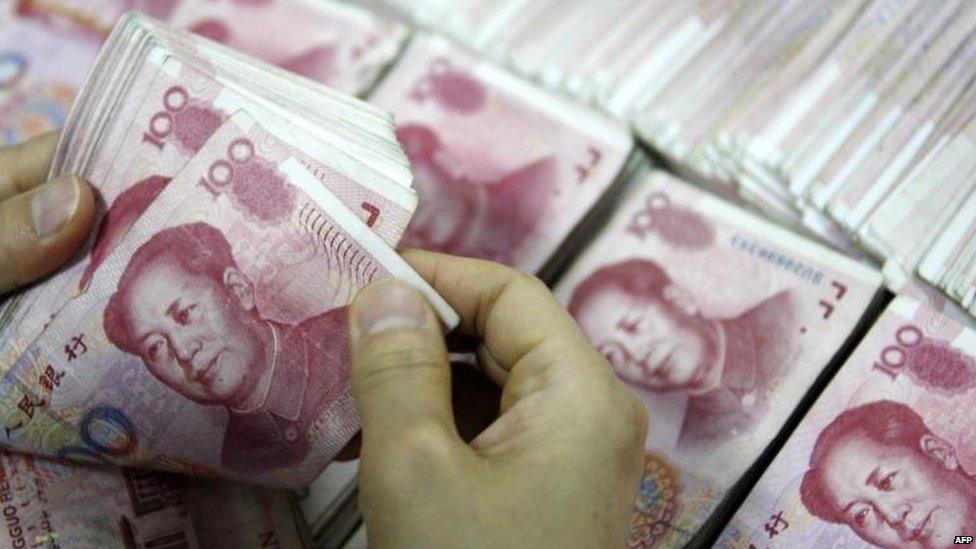Tough outlook for emerging markets
- Published

China's economic boom and slowdown will have profound consequences for the global economy
A series of emerging market currencies are losing value and stock markets across the developing world are in retreat. The more excitable parts of the financial sector - and indeed on financial twitter (yes, there is such a thing) - are talking of a re-run of the Asian Financial Crisis of 1997.
So, just to be clear, this is not a re-run of 1997. But that doesn't mean it isn't serious.
In 1997 much of Asia fell into a severe financial crisis. Countries like Thailand, Indonesia and South Korea had become dependent on foreign credit, and when it dried up they were severely hit. Currencies crashed, economies tumbled, unemployment soared and there was serious talk of a global financial meltdown.
The current situation is quantitatively different and rather than being a sudden episode of crisis, it feels like the culmination of some deeper structural changes in the world economy.
Emerging market currencies have lost value against the dollar and currently stand at a six-and-a-half-year low in aggregate. The Financial Times today, external reports that almost $1tn of capital has flowed out of emerging economies in the last 13 months.
After six years of near zero interest rates and extraordinary monetary policy such as quantitative easing (electronically creating money to buy bonds), the US Federal Reserve is close to the first interest rate rise in almost a decade.
The BBC's Samira Hussain looks at when the Federal Reserve will raise interest rates
With the returns available in the US on the rise, it's becoming a more attractive home for often footloose global capital. That's pushing the dollar up and driving the capital outflow from the emerging world.
A tightening of US monetary policy - especially after the last six highly unusual years - would always be an issue for emerging markets, but it comes at time when just about everything that could go wrong seems to be going wrong at the same time for them.
Three long trending factors that have supported economic growth - and financial market returns - across the developing economies appear to be either reversing or slowing.
The first is the process of economic globalisation itself - at least as expressed through world trade. As I've written before, for reasons that still aren't entirely clear, world trade has had a terrible few years.
Commodity price collapse
2015 looks set to be the fourth consecutive year in which world trade growth is slower than global GDP growth. This slowing makes the kind of export-led growth strategies that many (although not all) emerging economies have pursued that much trickier.
Secondly, there's commodity prices. The oil price has collapsed, from around $110 a barrel last summer to around $50 today. But it's not just oil, the price of things like industrial metals has collapsed too. Copper currently trades at a six year low.

The International Energy Agency has warned oil prices may not have hit their lowest price yet
For many commodity exporting nations this is little shortage of a catastrophe. Go back eight or nine years and the talk was of a "commodity super cycle": how the industrialisation of Asia would drive commodity prices ever higher. The "super cycle" looks to have turned.
Finally, financial conditions are getting tougher. This doesn't just relate though to the coming rise in US interest rates - although that is the catalyst for the recent sell-off.
The bigger picture is that long-term interest rates across the developed world of the US, Europe and Japan have basically been falling for thirty five years.
As the fund manager Bill Gross recently wrote, external long-term interest rates in the US were 14.5% in 1981. Today they're just 2.2%. Over the course of those years the Dow Jones Industrial Average of US shares has risen from 900 to 17,500.
In other words investors have had a very good few decades, much of it underpinned by falling borrowing costs.
But eventually a limit is hit, longer term interest rates can only fall so far. The fall in borrowing costs which underpinned the 35-year bull market in the West seems unrepeatable - unrepeatable at least if we rule out deeply negative longer term borrowing costs.
Add together slowing world trade, collapsing commodity prices and less easy global financial conditions, and you've got a recipe for a tough time for emerging economies. Not necessarily for a 1997-style meltdown, but certainly for an environment for lower growth and lower returns for investors.
Important component of global growth
To an extent you can bind all three factors into a single story - the story of China's boom and slowing.
Certainly China has been a driver of world trade growth and the single most important marginal driver of commodity demand in the last couple of decades.
It may also be connected to the falls in long term interest rates. As Toby Nangle of asset management firm Columbia Threadneedle Investments has argued, external, the integration of China into the world economy coincided with the falls in the cost of borrowing.
If nothing else, cheap Chinese manufactured goods helped to hold down inflation in the West allowing central banks to keep rates lower.
China's economy was always destined to slow - no country can maintain a 10% annual growth rate forever - but the consequences of that slowing will be felt far and wide.
Emerging economies have been an important component of global growth, especially since 2008. If that prop to the global economy is looking less firm, then that is a serious problem.
It leaves already indebted consumers in countries like the US and UK responsible for generating even more of global demand.
The outlook for emerging markets is tougher than it has been in years. But at least for the moment, reaching for the 1997 analogy feels like a stretch too far.
- Published17 August 2015
- Published11 August 2015
- Published16 April 2015
- Published2 March 2015